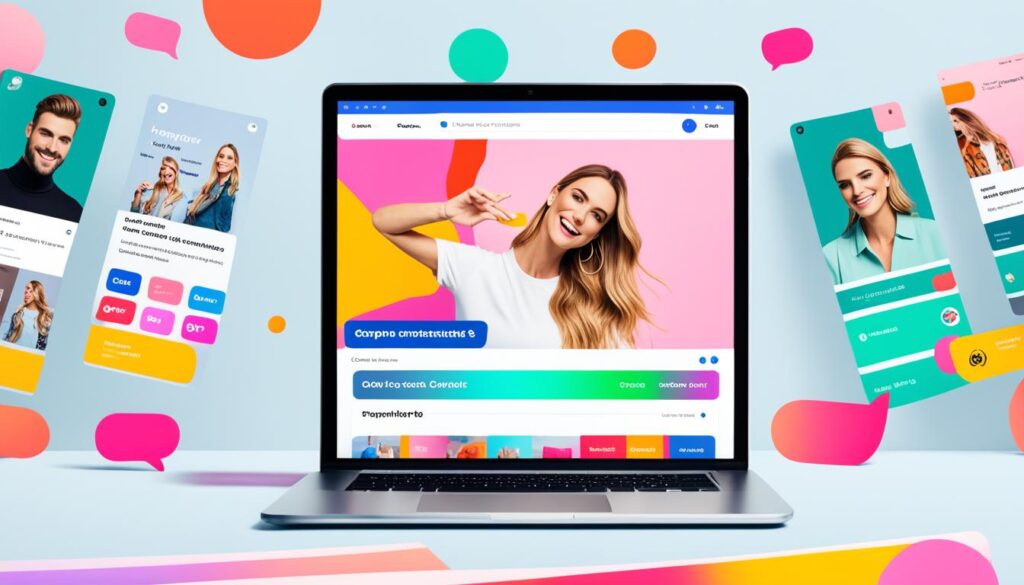Welcome to Advertising 101! This piece will go through advertising basics and their importance in campaigns. It’s for anyone keen on marketing or running a business. Knowing these basics can really boost your achievements and success.
Advertising is key for businesses to reach their audience. It can bring in more leads, raise earnings, and spread awareness about a brand. In our digital world, advertising on social media shines. Platforms like Facebook and Instagram let businesses connect with billions. That’s why many companies use social media ads to grow.
Social media ads are great because they’re affordable. They cost less than traditional ads. Plus, they let businesses talk to potential customers instantly. This ability to interact directly on the platforms customers use is a big advantage.
The Power of Social Media Advertising
Advertising on social media can really change the game. It lets companies connect with their desired customers through posts and ads. And because nearly everyone is on social media these days, ads can reach far and wide.
This kind of ad reaches people where they’re already active. It’s not just affordable, but it also helps with building loyalty over time. This makes it a good choice for businesses, no matter their size or budget.
If you’re looking to up your advertising game, we’ve got more tips. We’ll talk about how to make great social media ad campaigns. Stay tuned to learn the best steps and strategies. This will help you target the right people and make ads that work. Let’s dive in!
The Power of Social Media Advertising.
Social media advertising is crucial for businesses today. It helps them reach their target audience effectively and boost sales. Through social media, companies can interact with their customers and attract new ones. This approach leads to more sales and better connections.
Social media ads are great because they reach specific groups directly. This is different from traditional ads. Companies can pick exactly who sees their ads. They focus only on people who might actually buy their products, saving money and effort.
Also, social media ads are perfect for talking with customers. Companies can chat with them online. This builds trust and loyalty over time. It’s like turning followers into friends, making them more likely to buy again.
Moreover, these ads are not very expensive compared to other means. Businesses control how much they spend. They can choose where to put ads, whether it’s Facebook or somewhere else. This flexibility makes every cent count toward reaching the right audience.
In summary, social media ads help businesses in many ways. They reach out to potential customers, increase sales, and create strong bonds. Their budget-friendly nature and targeting skills make them a key part of any good marketing plan.
How to Create a Successful Social Media Ad Campaign.
Making a social media ad campaign work well needs some key steps. This guide will help you launch ads that your audience will love.
First, set your budget for the ad campaign. Think about your marketing goals and put enough money towards social media ads. This step helps you make sure your ads are cost-effective.
Select the Right Ad Types:
Social media platforms have different ad types for specific goals. For instance, Facebook offers image, video, and carousel ads. Look at what your target audience likes and what each platform does best. Then, pick the ad types that will meet your campaign’s goals best. This choice will make your ads more effective and engaging to your audience.
Focus on Relevance and Targeting:
Making your ads relevant is crucial for success. Use data, feedback, and research to know your audience better. Then, use the platform’s tools to reach them at the perfect times. Also, use good keywords to improve your ad’s search visibility.
Create Compelling Designs and Engaging Copy:
Good design and text are essential to attract your audience. Choose colors, fonts, and images that stand out but also match your brand. Then, write poerful copy that highlights your product’s value. A catchy ad increases the chances of selling your product or service.
Always keep an eye on how your ads are doing. Use the data to adjust and make your advertisements as effective as possible.
You now have the basics on running a successful ad campaign. Next, we’ll learn how to check if it’s working.
Measuring the Success of Your Social Media Ad.
After launching your social media ad campaign, it’s important to measure its success. You do this by tracking key performance indicators (KPIs). This gives you important insights to improve your strategies and get the best return on your investment (ROI).
1. Click-through Rate (CTR)
The click-through rate shows the percentage of people who click on your ad after seeing it. It tells you how engaging your content is. A higher CTR means your ad is interesting and it catches the eye of your intended audience. To up your CTR, work on making your ad’s copy and visuals really speak to your viewers.
2. Cost per Conversion (CPC)
The cost per conversion helps you see how cost-effective your ads are. It figures out the cost of each desired action, like making a sale or getting a lead. A lower CPC means you’re spending your money wisely and getting a better ROI. To lower your CPC, try different target audiences, improve your ad content, and keep testing to see what works best.
3. Conversion Rate
The conversion rate is the percentage of people who buy or take action after clicking your ad. It shows how well your ad and landing page work together. A high conversion rate means your ad is good at getting people to act. You can raise your conversion rate by improving your landing page, making your call-to-action clear and persuasive, and by ensuring a smooth user experience.
Examining these metrics and using analytical tools offers deep insights. These insights help you adjust your strategies by understanding what your audience likes best. So always keep measuring and improving your social media ad campaign. It’s an ongoing effort that involves constant fine-tuning.
Successful Social Media Advertising Examples.
Looking at successful social media ads can spark ideas for your campaigns. Here are some top examples from various companies on many platforms.
Dollar Shave Club
The Dollar Shave Club Facebook ad is simple and true to their image. It shows their products and the benefits of joining, talking straight to their ideal customers.
Dick’s Sporting Goods
Dick’s Sporting Goods shines on Instagram with eye-catching content. Their colorful ads never fail to make their audience stop and look, creating interest and buzz.
Postmates
On Twitter, Postmates aims for the young to middle-aged crowd. They use fun images and messages that connect, making their food delivery service look appealing.
Workhuman
Workhuman knows LinkedIn is great for reaching professionals. They advertise their work culture, hooking professionals looking for meaningful companies to work for.
Hopper
Hopper targets a youthful audience on Snapchat. Their use of filters and AR technology is both attention-grabbing and engaging, appealing to the tech-savvy.
These ads show how social media is a powerful tool when used well. They offer great lessons for improving your own ad strategies and reaching your marketing targets.

Understanding the Digital Landscape.
Digital marketing happens on various platforms like search engines and social media. Others include websites and email tools. Knowing each platform’s unique traits and who uses them is key to good marketing.
People mostly find info online through search engines like Google and Bing. They rank results based on the words users search for and what they want.
Social media sites like Facebook and Instagram are places to share and connect. They let businesses promote in ways that fit certain people’s interests and online actions.
Websites are like online shops where visitors can learn about and buy things. They can be made to show up more in search results, attracting more visitors.
Email marketing is another way to reach and grow relationships with customers. Businesses send emails about special offers, new products, and more to people who choose to get them.
| Platform | Characteristics | Audience Demographics |
|---|---|---|
| Search Engines | Provide search results based on keywords and user intent | Wide range of users seeking information or products/services |
| Social Media Networks | Platforms for connecting, sharing content, and targeted advertising | Vary by platform; Facebook: diverse, Instagram: younger audience, Twitter: news and trends, LinkedIn: professionals |
| Websites | Digital storefronts for businesses to showcase information and offerings | Varies based on specific business and target audience |
| Email Marketing | Direct communication with subscribers, nurturing leads, and promoting products/services | Depends on subscriber demographics and interests |
Unveiling the Pillars of Digital Marketing.
Digital marketing involves key pillars. These are vital for successful online marketing. They help you reach more people. And they bring in visitors to your site.
1. Pay-Per-Click Advertising
With Pay-Per-Click (PPC) ads, you pay only for clicks. This method puts your ads on search engines and other sites. It helps get immediate traffic and boosts your brand’s presence. Choosing the right keywords and improving your ad setup can make your investment more profitable.
2. Social Media Marketing
Marketing on social media means showcasing your brand and products on platforms like Facebook and Instagram. It’s a great way to interact with your audience and build brand trust. Also, it drives traffic to your site. Creating content that’s interesting and targeting the right people helps you connect with potential customers.
3. Content Marketing
Content marketing is about sharing engaging and useful content. This includes blogs, articles, and videos. It makes you a known expert in your field. Also, it helps bring more visitors to your site. This type of marketing is key for your site to show up in search results.
4. Search Engine Optimization
Search Engine Optimization is all about making your website more visible in search engines. Using the right keywords, improving your site’s structure, and getting quality sites to link to yours can boost your traffic. Higher search rankings mean more people find your page.
5. Email Marketing
Email marketing is very effective in turning potential customers into actual ones. By sending personalized emails, you build a connection with your audience. It also lets you provide exclusive content and promote your goods or services. With emails, you can talk directly to interested customers.
By combining these marketing elements, you form a strong online strategy. This strategy can boost your online visibility and attract more visitors. This, in turn, helps you make more sales.

| Pillar | Description |
|---|---|
| Pay-Per-Click Advertising | Display ads on search engines and websites, paying for clicks |
| Social Media Marketing | Promote brand and products on social media platforms |
| Content Marketing | Create and distribute valuable and relevant content |
| Search Engine Optimization | Optimize website to improve visibility in search engine results |
| Email Marketing | Nurture leads through targeted and personalized email campaigns |
Harnessing the Power of Digital Marketing Tools.
Digital marketing tools help you do better in an online world full of competitors. They give you key insights and make tasks easier. This way, you can spend more time making your campaigns strong to reach your goals.
Keyword Research
Looking for the right keywords is vital in digital marketing. Knowing what your audience searches online helps. Use tools like Google Keyword Planner and SEMrush for this. They show you the best keywords, how many people search them, and the competition. This lets you pick the most powerful keywords for your content.
Content Creation
Good content keeps your audience interested. Tools such as CoSchedule and BuzzSumo can boost your content strategy. They help with ideas, planning when to post, and checking how well your content does. You can see what’s trending, what your competitors are doing, and how to hold your audience’s attention.
Social Media Management
Social media is key for staying in touch with your audience. Hootsuite and Buffer make it easier to post across different platforms. They help you keep a steady stream of content and let you see how people are interacting with your posts. This improves your social media game.
Email Marketing
Email is still a top way to talk to your customers. Tools like Mailchimp and ConvertKit make emailing easier. They let you send emails automatically, organize your people into groups, and see how well your emails do. With these tools, you send out emails that really hit the mark.
Analytics
Understanding your marketing results is crucial. Google Analytics and HubSpot give you the data you need. They show how many people visit your site, what they do there, and if they buy something. With this data, you can see what works, where to improve, and make smarter choices for your marketing.
By using digital marketing tools, you can work smarter, get key data, and fine-tune your strategies. Whether it’s picking the best keywords, creating awesome content, keeping up with social media, running email campaigns, or checking how you’re doing, these tools help you succeed in digital marketing.
Conclusion.
Digital marketing is a key tool for businesses to succeed. It’s all about knowing online marketing well and using smart tactics. This helps businesses reach more people, make their brand known, and get more visitors to their sites.
The main parts of digital marketing include Pay-Per-Click ads, social media ads, content marketing, SEO, and email marketing. By combining these, companies can make strong marketing plans. These plans use what each part does best.
Using digital tools for things like finding popular search terms, making content, managing social media, sending emails, and looking at data can make work easier and do better. This way, businesses make the most of their marketing.
The digital world is always changing. So, companies need to keep up and change their plans to stay ahead. By keeping up to date, having clear goals, and using good digital marketing, businesses can do well in the digital age.
